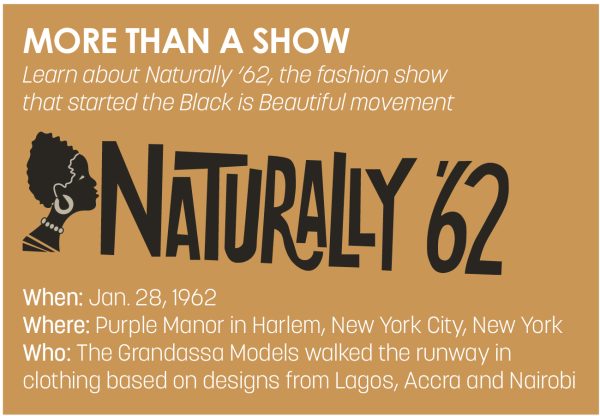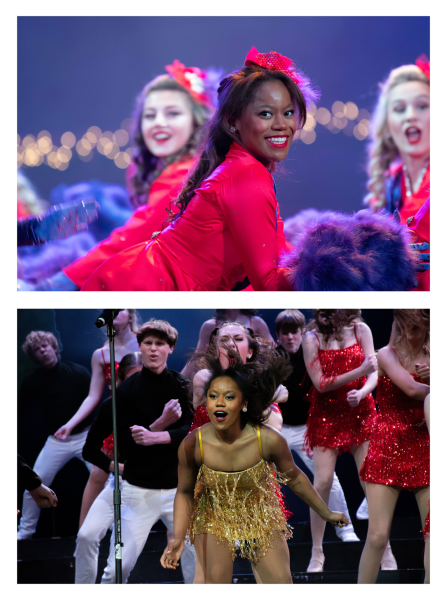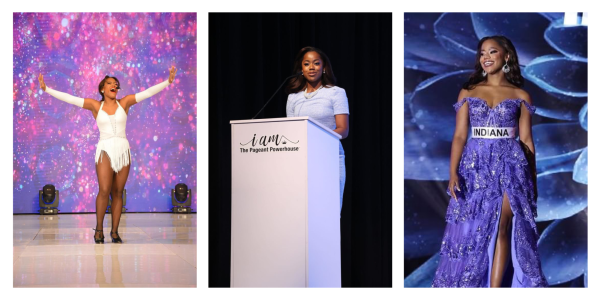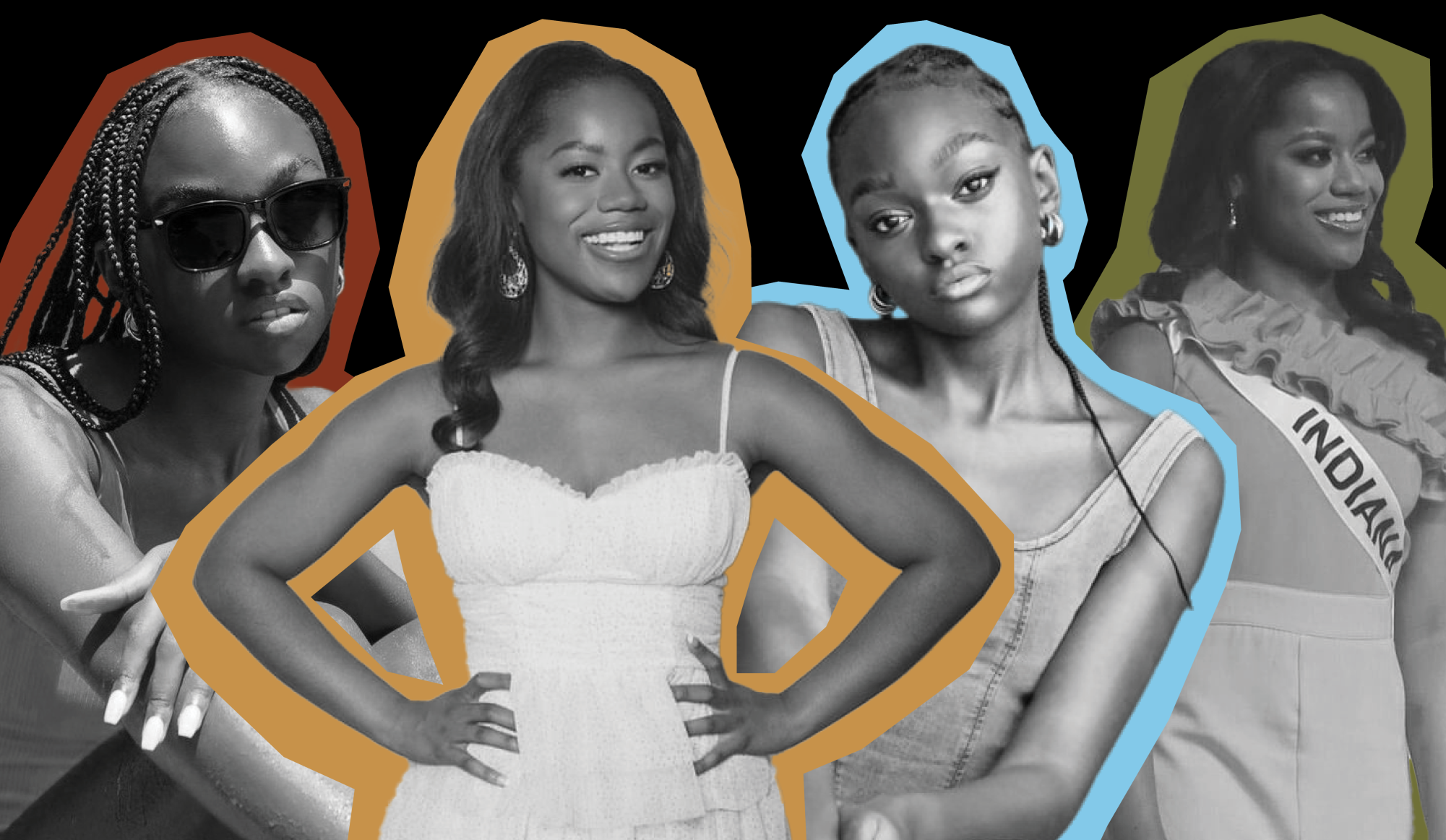Black is Beautiful

In 1962, in Harlem, New York, brothers Kwame Brathwaite and Elombe Brath hosted a fashion show with their artist collective, the African Jazz Art Society and Studios (AJASS). The show, titled “Naturally ‘62,” was created to celebrate African American culture and beauty and is considered the start of the historic Black is Beautiful movement.
While Brath died in 2014 and Braithwaite on April 1, 2023, their movement has remained relevant, spreading beyond the United States and to modern movements such as Black Lives Matter.
“History worth sharing”
On Friday, Nov. 17, 2023, senior Gabi Bradley was on her way to a national competition she never thought she would participate in.
Bradley had entered the National American Miss (NAM) Indiana Teen beauty pageant out of curiosity and on a whim, but ultimately won the competition, making her the 2023 titleholder.
Having participated in dance and theater from a young age, Bradley said, “A lot of my prior training and things like that have helped me with the dance (and) helped me with the walk and musical theater and all the acting stuff helped me with my introduction to speak well.”

Regarding diversity in the pageant industry, Bradley said, “I was honestly surprised. …I can only speak to NAM because I’ve only ever done NAM, but I think NAM is so diverse, just looking at the diverse people that win and the way that it’s all shapes and sizes, it’s all different colors.”
Bradley said she had assumed the pageant industry would lack diversity partially because she had seen a lack of diversity in related fields such as dance and theater.
Jayden Drew, fashion model and senior, said she has seen this same lack of diversity in modeling. Drew said she saw much more representation in runway modeling and high fashion, but in her experience, that representation hasn’t yet reached her field of catalog modeling.
“I would say more my field, like catalog, is definitely the typical beauty standard: blonde hair, blue eyes. When you think of beauty standards, you think of that,” Drew said.
This underrepresentation can be seen on a wider-scale. According to The Fashion Spot, as of spring 2019, only 32.9% of models in major advertising campaigns were people of color.
Regarding existing representation, Bradley also said she didn’t feel like she fit the expectations of a Black performer in musical theater and dance.
Music from African American productions such as “The Color Purple,” “DreamGirls” and “The Wiz” require a style of voice Bradley said she’s unable to accomplish, making her feel like she couldn’t meet the standards of famous African American representation in her field.
“The way that I sing, I don’t really sing like Jennifer Hudson, or Cynthia Erivo, the typical Black musical theater performer. I don’t sing like that, I just can’t, sorry…they expect Black performers to sing like (that), and I don’t,” she said.
Olivia Uzodima Ekeh, postdoctoral fellow at the Center for Research on Race and Ethnicity in Society at IU, said she agreed with Bradley that Black artists can feel additional pressure.
“There’s no doubt in my mind that young Black women especially feel the push and pull between these realities of living and existing an authentic way that can simultaneously mean being on the receiving end of intense scrutiny,” she said.
To help alleviate that pressure, James Ziegler, AP African American Studies teacher, said diverse representation is important for communities and individuals, especially youth.
“(Representation makes) people feel that they too are important, that they too have a history that’s worthy of sharing. That there are people like them that are making contributions in a positive way to our history, to our society. …So I think the importance of the Black is Beautiful movement today in the 21st century is that importance of representation, of being able to see yourself,” Ziegler said.
Drew and Bradley both said they have experienced mainstream beauty standards that felt unrelatable and unrepresentative.
Drew, who sometimes wears her hair naturally in an afro, said other kids would try to touch her hair repeatedly in middle school. Drew said she still feels confident wearing her hair naturally, but she understands why other Black students would choose not to in order to avoid the uncomfortable situations.
Bradley said, “It’s difficult growing up seeing all of your other friends getting male attention or all of your other friends getting told how beautiful they are all the time and you don’t. Even when I was 13, 14 years old, I was being told, ‘Oh, you’re a 4 (because) I don’t like Black girls and Black girls are ugly or whatever.’”
Ekeh said beauty standards for Black people can be contradictory and arbitrary.
“On one hand, Black people are told our bodies are nothing to be ashamed of and we need to be diligent about de-prioritizing white supremacist contracts of beauty. And yet Black folks’ bodies are regularly over-sexualized sometimes without provocation and/or when one leans into liberated expressions of the body,” Ekeh said.
Bradley said she was glad NAM placed less of an emphasis on aesthetic beauty and more on talent and speech.
Beauty pageants emphasize different qualities from their contestants, with competitions like Miss USA emphasizing aesthetics while competitions like Miss America emphasize factors such as speaking ability.
For NAM, Bradley said, “(Scoring) was 30% your walk, like formal gown, 30% your personal introduction, 30% for your interview and 10% for your community involvement.”

Bradley and Drew said they both met Black mentors they could look up to in their respective industries.
Black women have come to hold many titles in pageantry, a historically segregated industry.
In 2019 alone, the Miss World, Miss Teen USA, Miss America, Miss USA and Miss Universe titleholders were all Black women. Bradley has been able to see herself in other titleholders of color, such as Faith Pierre Charles, the 2022 International Junior Miss titleholder.
Bradley said Charles inspired her as a Haitian woman because her grandparents immigrated from Haiti.
“That was super exciting for me because I was like, oh my goodness, somebody who looks like me, who came from the same country that I came from (won),” Bradley said.
Drew said she has not been exposed to many Black models in her agency to learn from.
Drew said, “In my agency we have modeling classes and stuff like that, so I feel like the teachers are usually like the typical white women. And I feel like if we have more teachers who will look more like us, it’ll be easier to understand because they understand what they had to go through to get to the point they are now.”
Still, Drew said she also met a mentor, model Michaela Duerson.
“She’s a model with Fenty, Kohls, Nike and stuff like that. And she is a plus-sized Black woman and she’s really helped me through this entire process so much. And she’s also one of my favorite photographers. On my modeling page, most of my pictures are by her and she really just sees me for me and she understands my potential and where I could be,” Drew said.

“Not the target demographic”
According to the United States Census Bureau, in Carmel, African Americans make up one of the smallest racial demographics at 2.8% of the total population, smaller than white, Asian and multiracial groups.
Drew moved to Carmel in middle school but grew up in Lawrence Township in Marion County.
“Just coming inside (Carmel Middle School) is like a culture shock,” Drew said.
Drew said she felt more desired in Lawrence Township, where the Black population is more than 13 times greater than Carmel, accounting for 38% of the community.
Bradley grew up in Carmel, but said she agreed with Drew’s feelings of being the outlier.
Bradley said, “I know I’m not the target demographic if that makes sense, and there’s nothing I can do for that.”
Drew and Bradley both said being the minority has caused them to seek out opportunities for themselves rather than waiting for them to come. Drew submitted herself to multiple modeling agencies until she was signed to the Helen Wells Agency. Bradley entered the NAM Indiana Teen pageant and researched the pageant process herself.
Bradley said making opportunities for herself is a way to embrace the Black is Beautiful movement. Bradley said, “You can’t wait for other people to see how amazing you are to start seeing it in yourself because you’re just going to be waiting forever and nobody has that kind of time.”
Drew said that she had also embraced Black culture by educating herself on Black history. Drew is currently taking the AP African American Studies pilot course after taking the African History course junior year.
Ziegler said African American pioneers have historically taken opportunities to create representation for Black culture when mainstream media has neglected or underrepresented them.
Regarding Brathwaite and Brath’s creation of the Black is Beautiful movement, Ziegler said, “I think one of (Braithwaite’s) biggest contributions was as one of these contemporary pioneers who helped create an environment where you can feel accepted being you and you can feel validated and honored just for being who you are. And that personal impact can’t be overstated–how that can impact the psyche of a group of people.”
Ziegler said the Black is Beautiful movement has deep roots in African American culture, even before “Naturally ‘62,” seen through leaders in movements such as the Harlem Renaissance, including Marcus Garvey, who advocated for Black Nationalism and pride.
Ziegler said he discusses the concept of “Black Founders” in AP African American Studies, defining Black Founders as African American leaders who challenge the stereotypes and limitations placed on them. Ziegler said he hopes pioneers such as Braithwaite inspire future generations of Black youth to do the same.
Ziegler said one of his goals in teaching AP African American Studies for the first time this year is validating African American history and culture that is often left out of traditional United States history courses.
“Too often with curriculum still white-washed in the classroom, if you’re not able to see yourself in representation in a positive light in the classroom, or you’re not even seeing (yourself) represented other than historical traumas, you don’t get that full sense of self,” he said, “You don’t get that full identity.”
Ekeh said African American youth are particularly motivated to create representation when mainstream culture does not.
Ekeh said, “I’d go as far to say that most Black youth culture emerges from working class experiences which are never wholly represented in the mainstream while simultaneously influencing those at the center of mainstream culture.”

“Beautiful, worthy, excellent, smart”
Ultimately, Bradley said pageantry has surprisingly improved her self-esteem and her perception of African American beauty and Drew said the same about modeling.
Bradley said, “(I assumed) it’s always going to be the prettiest one, the prettiest (white) girl’s gonna win like how everything always goes, and that didn’t happen. Me and my friend Lily tied, she got first runner up I got first overall and she’s also Black. And I was like, ‘Dang, we are pretty aren’t we!’… You (can) feel like ‘I’m not worthy cause everyone else is beautiful’ or you can be like, ‘Wow, we’re all so beautiful.’ It’s like that mindset shift.”
Ekeh said the Black is Beautiful Movement aimed to change beauty standards both in mainstream culture and Black culture.
Ekeh said, “Black is Beautiful elevated darker complexions not only as beautiful but pushed back against the hierarchy of colorism that resulted in darker-skinned folks being characterized in derogatory ways.”
Ekeh said the movement also focused on African American women’s culture. “There was an emphasis on centering Black women in the movement. From choosing natural hairstyles that didn’t require chemical manipulation, to bright color fashion inspired by African clothing,” she said.
Drew said modeling has allowed her to gain confidence. Despite working in a field she’s underrepresented in, she’s said she’s able to express her style through fashion and wants to continue pursuing a career in runway modeling.
Bradley said, “Some people perceive that the (Black is Beautiful) movement is trying to tell other people that Black is Beautiful, like we’re trying to say ‘Hey! Black is Beautiful! … (but) the Black is Beautiful movement is a reminder to all of us Black women, Black men, (Black people) everywhere that you are beautiful, you’re worthy, you’re excellent, you’re smart. Even if other people don’t see that, don’t wait for it. You have to see it cause that’s the only way you’re going to get anywhere–is when you start to realize that for yourself.”



